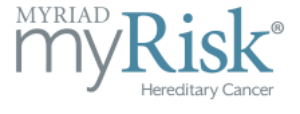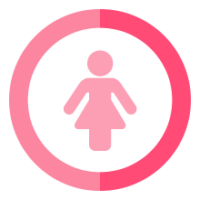Dr. Santillan uses Myriad myRisk hereditary cancer panel which represents the next generation of hereditary cancer risk testing, blending both genetic status AND personal cancer family history. Myriad myRisk identifies elevated risk for breast cancer by analyzing multiple, clinically significant genes.

Women in the U.S. General Population
About 7 out of 100 women in the U.S. general population will get breast cancer by age 70.

Women with a BRCA1 or BRCA2 Mutation
About 50 out of 100 women with a BRCA1 or BRCA2 mutation will get breast cancer by age 70.

A woman with a BRCA gene mutation will have inherited the mutated gene from her mother or her father. Likewise, she may also pass the BRCA gene mutation down to her children. This is why many women talk about having a family history of breast cancer or hereditary breast cancer.
It is important to know that just because you have a BRCA gene mutation, it does not mean you will pass the mutation down to your children. Additionally, just because your mother or father have a BRCA gene mutation, it does not mean that you have inherited the mutation.
There are several other genes that have been linked to breast cancer.
While these genes have all been linked to breast cancer, the most commonly discussed genetic mutations are the BRCA genes.
BRCA gene testing can be done to determine if you have a mutation in your BRCA 1 or BRCA 2 genes. Dr. Santillan uses Myriad myRisk hereditary cancer panel which represents the next generation of hereditary cancer risk testing, blending both genetic status AND personal cancer family history. Myriad myRisk identifies elevated risk for breast cancer by analyzing multiple, clinically significant genes, including all the genes described above.
A BRCA gene mutation means that you have a higher risk of developing breast cancer and/or ovarian cancer than someone who doesn’t have a BRCA gene mutation. It does not guarantee that you will get cancer. As a result, some women choose to do nothing. Some women choose hormonal therapy. And some women choose to have surgery to remove the breast tissue or ovaries, or ovaries and fallopian tubes that are at risk of developing cancer.
If you have a positive cancer diagnosis in one breast and you have a BRCA gene mutation, you may choose to have a risk-reducing mastectomy on your healthy breast to potentially reduce your risk of developing cancer in your healthy breast. You may also opt for breast reconstruction.
In a risk-reducing oophorectomy, the ovaries that are at risk for developing cancer are removed.
In a risk-reducing salpingo-oophorectomy, the ovaries and the fallopian tubes that are at risk for developing cancer are removed.